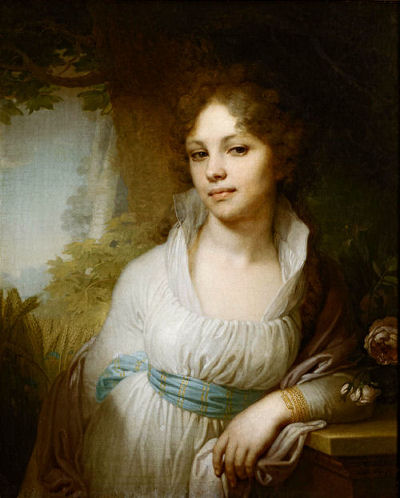
Oil on canvas. Tretiakov Gallery, Moscow.

 This portrait is one of my favorite Russian paintings from the 18th
century. Every aspect of it is carefully controlled and directed to produce
a certain effect, to create an atmosphere that is both in accord with,
and slightly differing from, the prevailing neoclassical style of the day.
This is reflected in the subtle natural background, the classic simplicity
of Madame Lopukhina's dress, and the cool sense of decorum, individual
calm, and quiet assurance that is transmitted through the combined effect
of these and other details. At the same time, Madame Lopukhina's image
reflects many characteristics of Borovikovskii's style that depart from
standard neoclassical practice. This portrait, for instance, is far less
ceremonial than many that were produced at the time. Madame Lopukhina is
not decked out in her finest clothing, she is not depicted among rich surroundings,
neither is she stiff and artificially posed. Rather, she is dressed unostentatiously
and placed in an obscure natural background, which while it conforms to
the neoclassical idea of nature's secondary position, contrasts with the
formality often associated with neoclassic 'symbolic' portraits. Her pose,
too, though it may not be natural, at least seems to be so. The "languid"
position of her body, her facial expression, the tilt of her head, all
combine to create a sense of individual character. Madame Lopukhina is
here at ease, in her natural state of mind and a psychologically revealing
pose. Her gaze is familiar, her eyes expectant, her mouth bantering, while
her posture indicates a relaxed, confident poise.
This portrait is one of my favorite Russian paintings from the 18th
century. Every aspect of it is carefully controlled and directed to produce
a certain effect, to create an atmosphere that is both in accord with,
and slightly differing from, the prevailing neoclassical style of the day.
This is reflected in the subtle natural background, the classic simplicity
of Madame Lopukhina's dress, and the cool sense of decorum, individual
calm, and quiet assurance that is transmitted through the combined effect
of these and other details. At the same time, Madame Lopukhina's image
reflects many characteristics of Borovikovskii's style that depart from
standard neoclassical practice. This portrait, for instance, is far less
ceremonial than many that were produced at the time. Madame Lopukhina is
not decked out in her finest clothing, she is not depicted among rich surroundings,
neither is she stiff and artificially posed. Rather, she is dressed unostentatiously
and placed in an obscure natural background, which while it conforms to
the neoclassical idea of nature's secondary position, contrasts with the
formality often associated with neoclassic 'symbolic' portraits. Her pose,
too, though it may not be natural, at least seems to be so. The "languid"
position of her body, her facial expression, the tilt of her head, all
combine to create a sense of individual character. Madame Lopukhina is
here at ease, in her natural state of mind and a psychologically revealing
pose. Her gaze is familiar, her eyes expectant, her mouth bantering, while
her posture indicates a relaxed, confident poise.
One of the most noticeable elements of Borovikovskii's technique in this painting, which contrasts with common neoclassical practice and some of his other works, is the soft-focus nature of the portrait. Even more obvious is his delicate use of color to create a harmonious atmosphere in which, again, Madame Lopukhina's presence is a natural occurrence. The cool tones of the background, her dress, and her sash are softly contrasted with the warmer tones of her face and neck. Though aesthetically pleasing on its own, the color scheme has a more important place in this portrait, accentuating her figure through an elegant luminescence that is only heightened by the dimming of the corners. Together these elements may create a slightly 'sentimental' portrait, but one that is nevertheless effective, and testifies to Borovikovskii's skill and importance as an 18th century Russian painter. At the same time, it reflects the "elegance" typical of the best 18th century Russian painting and supports the idea that Borovikovskii "was at heart a realist who never failed . . . to create a likeness" (Hamilton, 351). [C.B.]
In 1797, Mariia Ivanovna Lopukhina was just eighteen years old and married to a man ten years her senior. Since so many marriages in Russia were arranged, there were speculations that the portrait shows Mariia's sadness and sorrow. Perhaps the mood of the sitter reflects her illness (tuberculosis), which, just three years later, caused her death? The mystery of the portrait remains, as described by the poet Iakov Polonsky who, in 1885, dedicated the following poem to it:
She passed so long ago, and carried to her grave
Those eyes and smile—which silently expressed
Her pain – a trace of love, her thoughts – a trace of stress,
Her beauty, though, Borovikovsky saved,
Keeping a part of her soul from harm.
And now that gaze of hers and her body’s charm
May draw indifferent heirs and teach them, it would seem,
To love and to forgive, to suffer and to dream.
